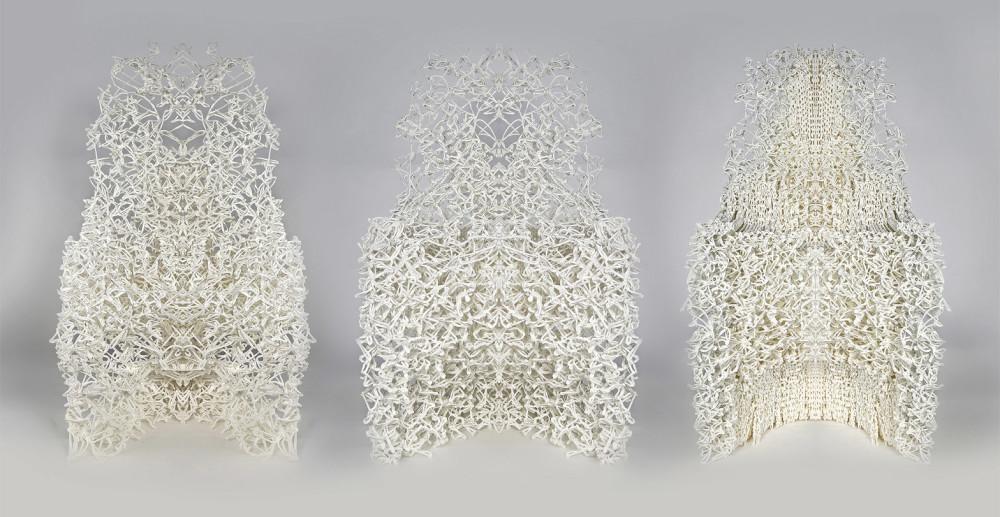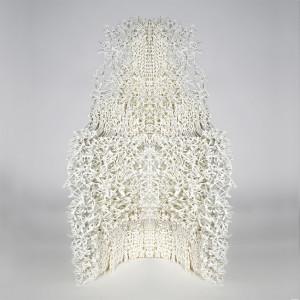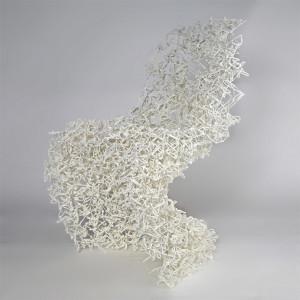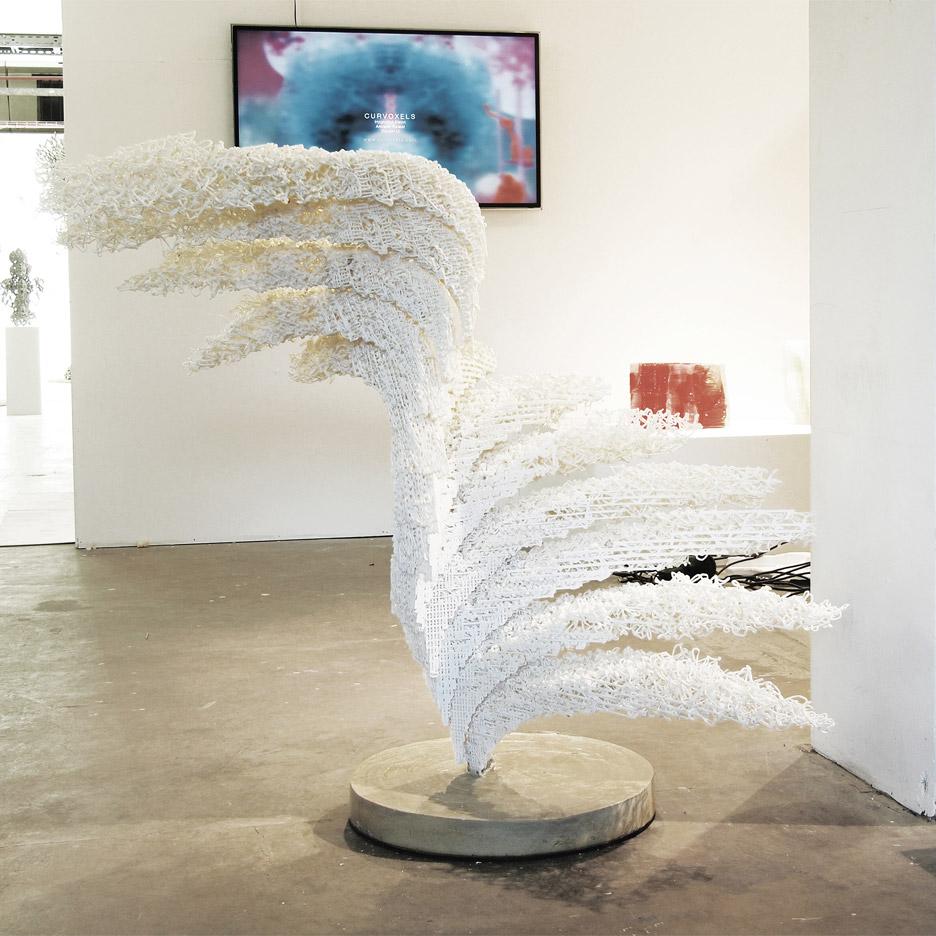A group of students from the Bartlett School of Architecture at the University College London called CurVoxels have developed a new 3D printing technique that allows them to 3D print complex curved, three-dimensional structures. The team used the new process to build a set of intricately printed filigree cantilever chairs and a filigree spiral staircase. The Spatial Curves project was completed by the team at Bartlett’s Research Cluster 4, where the custom-made 3D printer was used to create the team’s own version of the iconic Panton chair. The chair was designed in 1906 by Danish designer Verner Panton and is the world’s first molded plastic chair.
Panton regularly redesigned his famous chair, and other designers would routinely apply their own design aesthetic to create their own versions of the classically shaped cantilever chair. For the Spatial Curves project, not only did the CurVoxels team choose to design their own version of the Panton chair, but they wanted to completely reinterpret how it was made. The goal was to see if their new 3D printing process could be applied to a previously existing 3D design. After successfully fabricating their own chairs, the team presented their project at Bartlett’s B-Pro Show 2015 graduation exhibition held in London and again at the Synthetic 2015 Exhibition in Le Mans, France.
 The process of constructing the chair starts when the 3D model is voxelized, which is a process of breaking down an object into small “volumetric pixels.” The individual voxels are converted into a basic spatial curve, which is capable of adopting different orientations as well as generating various patterns throughout the chair. The size of each voxel changes depending on the amount of weight that the chair needs to accommodate and the 3D printing material is distributed in different densities. If the voxels are very small, the spatial curve essentially becomes a simple line, while larger voxels can become various patterns like the filagree design of the final chairs. The first simulations conducted twelve different design options that tested toolpath continuity, any resulting patterns, printability and the final object final density.
The process of constructing the chair starts when the 3D model is voxelized, which is a process of breaking down an object into small “volumetric pixels.” The individual voxels are converted into a basic spatial curve, which is capable of adopting different orientations as well as generating various patterns throughout the chair. The size of each voxel changes depending on the amount of weight that the chair needs to accommodate and the 3D printing material is distributed in different densities. If the voxels are very small, the spatial curve essentially becomes a simple line, while larger voxels can become various patterns like the filagree design of the final chairs. The first simulations conducted twelve different design options that tested toolpath continuity, any resulting patterns, printability and the final object final density.
The 3D printer that was created by the team included a custom nozzle that is capable of extruding four- to six-millimeter-thick strings of the plastic filament that would completely solidify in the air. The robot 3D printer simply printed in three-dimensional space rather than along a two-dimensional additive layering process. An algorithmic technique was developed to control the amount of material that is extruded, as well as the specific path that the printer would take in order to print the chair in a continuous extrusion. This allowed the team to 3D print the chair completely uninterrupted, which was faster, used less material and produced a more solid piece of furniture while maintaining a high degree of detail. The designers also developed an app that allowed them to alter the pattern and increase density while it was being 3D printed in order to improve structural integrity.
“CurVoxels has developed an experimental digital technique for creating complex curvilinear space frame structure such as columns, chairs, staircase and pavilion, based on Mereology with one simple component by using combinatorial system and seamless large scale spatial 3D printing. Basically, Spatial Curves integrated the areas of digital design system with digital fabrication systems and has the objective of optimising the potential of computational design in architecture by overcoming the limitations of fabrication inherent to previous digital architectural design,” said the CurVoxels team of their project.
Here is some video of the filagree chairs being 3D printed:
Team CurVoxels is Hyunchul Kwon, Amreen Kaleel and Xiaolin Li, and their project tutors were Manuel Jiménez García and Gilles Retsin.
The goal of their project was to develop a new process of using advanced robotics to produce large-scale 3D printed objects. They chose the Panton chairs as a proof of concept, but the fabrication technique is applicable to virtually any type of furnishings, structural component or architectural feature. Tell us your thoughts on this project in the Architectural 3D Printing forum over at 3DPB.com.
[Images: CurVoxels]Subscribe to Our Email Newsletter
Stay up-to-date on all the latest news from the 3D printing industry and receive information and offers from third party vendors.
You May Also Like
DyeMansion Debuts Polymer Post-Processing Solutions at Formnext 2024
DyeMansion is shaking up post-processing workflows with three new solutions unveiled at Formnext 2024. Under the motto It Just WorX, the company introduced the Powershot X for blasting and surfacing,...
Nano Dimension Expands Micro-Manufacturing with Exa 250vx 3D Printer
As it continues to push for the acquisitions of Desktop Metal and Markforged, Nano Dimension has introduced a new micro-3D printing system at Formnext. Adding to the Fabrica Tera and...
3D Systems Pushes New Tech and Partnerships at Formnext
As one of the pioneering companies in additive manufacturing (AM), 3D Systems remains a key player to watch at Formnext 2024, where it is showcasing major partnerships, innovative technologies, and...
Formnext Day Three: Rock & Zoll
The biggest news on day three was, of course, the reactions to the band at the exhibitor’s party. The soirée was well attended, with the crowd rocking on until early...











































